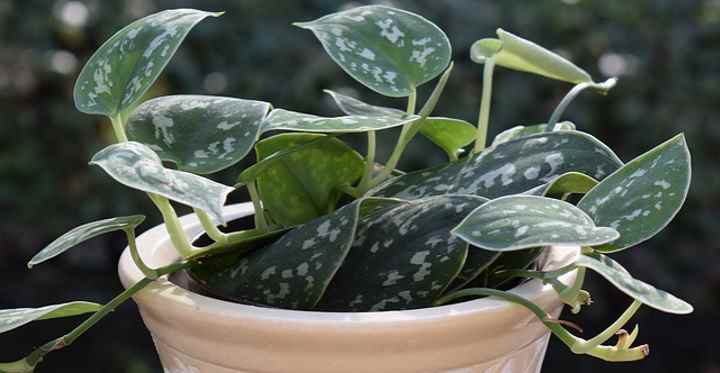Satin Pothos (Silver Pothos) Care: Growing Scindapsus Pictus

The satin pothos (Scindapsus pictus) is a vine plant that has dark green leaves with silvery markings. Also called the satin silver pothos, this slow-growing trailing houseplant is very easy to care for. The eye-catching tropical plant looks stunning, growing in hanging baskets or climbing up a moss pole. Other names for this pretty plant include silver vine and Scindapsus pictus ‘Argyraeus.’ It is also mistakenly referred to as a Philodendron Silver.
How to care for satin pothos: the Scindapsus pictus thrives in potting soil that drains well, bright filtered sunlight, medium to high humidity and a temperature range of 65°F to 85°F (18°C – 29°C). Water only when the top 2” (5 cm) of soil is dry and fertilize monthly during the growing season to help it grow faster.
In this article, you will learn about the best way to care for satin pothos. There is also advice on how to resolve a few growing issues with this popular houseplant.
What is Satin Pothos (Silk Pothos)?

Scindapsus pictus ‘Argyraeus’ is commonly called satin pothos, silver pothos and silver Philodendron, but is not a true pothos or Philodendron
The silver vine pothos is native to tropical rainforests of Asia. The long stems can grow up to 10 ft. (3 m) long, and they grow heart-shaped leaves.
When growing in pots indoors, the satin pothos has trailing stems up to 3 ft. (0.9 m) long. With regular pruning, satin pothos plants can make excellent potted plants with bushy foliage. Or, you can hang them in a basket in a bright location.
Part of the scientific name of the silver satin pothos—pictus—literally means painted. This refers to the variegation of silver dots and blotches on the matte green foliage.
There are many species of plants called pothos. However, true types of pothos are from the genus Epipremnum, for example the golden pothos /devil’s ivy (Epipremnum aureum).

The golden pothos (Epipremnum aureum) is a true type of pothos plant which comes from the genus Epipremnum
Satin Pothos vs. Philodendron Silver
The satin pothos is almost identical to the Philodendron silver plant; however, they are a different species. Both plants have long trailing vines, heart-shaped leaves, and silver variegation. Mix-ups also occur because sometimes, the common names for these plants are used interchangeably.
However, the satin pothos (Scindapsus pictus) is neither a type of Philodendron nor a type of Epipremnum (common pothos plants). The confusion arose because the satin pothos used to be classified in the genus Epipremnum and the common name ‘pothos’ stuck.
Types of Satin Pothos (Scindapsus pictus)

In this picture: Scindapsus pictus ‘Exotica’
There are a few different Scindapsus pictus cultivars to choose from. All of them have variations in variegation that affect the number of silver markings on the leaves. Generally, to care for satin pothos with lighter leaves, you should place them in a brighter location.
The three main satin pothos types to choose from are: Scindapsus pictus ‘Argyraeus’ with sparse silver variegation, the Scindapsus pictus ‘Exotica’ that has heavier variegation that looks like silver splashes, and the Scindapsus pictus ‘Silver Ann’ that has silver pothos leaves.
How to Care for Silver Satin Pothos (Scindapsus pictus)
Let’s look in more detail at how to look after a satin pothos at home. This guide includes tips on how often to water a pothos, when to repot the plant, and how to propagate them.
Light Requirements for Silver Pothos (Scindapsus pictus)
Satin pothos plants need plenty of bright, indirect sunlight to thrive. The best location for this hanging potted plant is in near an east- or west-facing window where it gets some morning or evening sun. Avoid placing the silver leaf pothos in the sun’s direct rays to avoid scorching them.
Silver pothos is a plant that you can grow in low-light conditions. However, you may find that the plant’s vines become sparse and leggy and look unkempt. The lack of adequate light may also cause the silver variegation to lose its vibrancy. If you notice that leaves of your scindapsus pictus become darker, move it to a brighter location to encourage faster growth.
The minimum temperature for silver pothos houseplants is 60°F (15°C). So, you can grow pothos plants outdoors as long as it’s sunny and the temperature is above 65°F (18°C). Place the scindapsus pictus plant pot in a bright location where it gets filtered sunlight. Avoid placing on a deck, patio, or windowsill where it’s in direct sunlight all day.
Best Soil for Growing Silver Satin Pothos
Satin pothos (Scindapsus pictus) needs to grow in a rich, well-draining potting mix. The best type of potting medium should have organic matter to hold moisture but be light enough so that water drains freely. The plant’s growth will slow down if it grows in soggy, waterlogged soil.
It is easy to make a suitable potting medium for growing silver satin pothos. You should mix equal parts of potting soil, peat moss, and perlite. Instead of perlite, you could add charcoal pieces or coco coir chips to help increase drainage. The peat moss keeps the soil moist so that the roots get nourished.
The best way to know if the soil is light enough is to water it thoroughly. If the water pools on the soil surface or takes a while to drain, you should aerate the soil. Alternatively, if the soil drains too quickly and you have to water the satin pothos more often, add more sphagnum peat moss.
How to Water Satin Pothos Houseplant
You should water satin pothos as often as the top part of the soil dries out. In summer, the scindapsus pictus plant may need watering as often as twice a week or more. In winter, the silver leaf pothos requires less frequent watering. The goal of watering is to make sure that the roots are always slightly moist.
To check when to water your pothos plants, firmly press on the potting soil to check for moisture. If there are hints of dampness, leave for a few days until the top part of the soil dries completely. You can also check the pot’s drainage holes—the soil at that end should be slightly damp.
How often you water your satin pothos depends on several factors such as:
- Air temperature—You will need to water your scindapsus pictus plant less often in winter than in summer. Plants respire less in cold months and give off less moisture. In summer, check the plant every few days to see if it needs watering.
- Type of pot—Soil in terracotta pots evaporates faster than potting mix in plastic or ceramic pots. So, satin pothos growing in unglazed clay pots may need watering more frequently.
- Type of soil—The soil density will impact how often your plant requires hydration.
The best advice for watering houseplants is to check that the top 2” (5 cm) of soil is completely dry. Then give the plant a thorough watering.
To thoroughly water your pothos, pour enough filtered water or rainwater until it drains out the bottom. This watering technique ensures that the roots get enough hydration to stay healthy. Allowing the plant’s soil to partially dry between waterings helps make sure roots don’t become soggy and diseased. You also avoid problems of fungus gnats and white mold on plant soil—issues that afflict houseplants when the top part of the soil is constantly damp.
The Best Indoor Temperature for Scindapsus Pictus
Satin pothos plants experience the best growth in a temperature range of 65°F to 85°F (18°C – 29°C). Constant average room temperature is similar to their native tropical environment. To grow well, protect the plants from sudden changes in temperature.
It can be challenging to get the right temperature in summer or winter. For example, the plant’s growth could slow down if it’s too close to hot radiators in the winter. Also, cold drafts could cause its beautiful green and silver leaves to wilt, curl, and turn brown. In the summertime, temperature issues could be caused by hot sun beating through windows or cold airflow from the air conditioning.
The Right Humidity for Growing Satin Pothos at Home
Silver satin pothos plants are tropical houseplants that require medium to high humidity to grow well. Aim for humidity levels of at least 40% for the fastest growth. The ways to get humidity levels right for Scindapsus pictus plants is to mist the leaves daily, place on a pebble tray, or use a room humidifier.
Let’s look briefly at some care tips to boost levels of humidity for pothos plants:
- Misting—Pour distilled water in a spray bottle and spray a fine mist over the top of the plant.
- Pebble tray—Place a layer of small stones in a tray and half-fill with water. Put the satin pothos pot on the pebbles, and the evaporation will help to humidify the leaves naturally.
- Room humidifier—Keep your indoor humidity levels high with a humidifier.
- Location—You can also place your pothos in a well-lit bathroom or kitchen where humidity levels tend to be higher.
How to Fertilize Silver Satin Pothos
Silver pothos isn’t a fast grower and doesn’t need a lot of fertilizing. Feed your scindapsus pictus plant once a month during the growing season with a diluted houseplant fertilizer. Stop feeding during the winter months and then resume in spring when growth becomes vigorous.
The right amount of fertilizer also helps to keep its stunning foliage healthy and vibrant. If you notice that the leaf color begins to fade, make sure and feed it monthly. Or, you could use a slow-release fertilizer. These granules will give a steady supply of essential nutrients as often as you water the plant.
It’s important to remember that too much fertilizer can be just as bad as starving it of nutrients.
How to Prune Satin Pothos
Silver satin pothos plants rarely require pruning. However, you can encourage bushier growth by snipping off the ends of stems. Also, you could prune the trailing stems if they get too long. Another reason to trim a scindapsus pictus plant is to get stem cuttings for propagation.
The best time to prune a satin pathos is in spring, just before it starts growing faster. Check the plant for any dead leaves or damaged stems. Prune as necessary.
If you are pruning to propagate the plant, snip off at least a 4” (10 cm) section of stem that has two or three leaves on it.
Easy Satin Pothos Propagation Tips
Stem cuttings rooted in water is the best method for silver satin pothos propagation. Trim off a stem just below the node and put the cutting in a jar of water. Wait a few weeks until roots about 1” (2.5 cm) appear. Plant in a suitable container that has a fresh potting mix.
Satin pathos plants can grow in water for a few months. However, you will eventually need to transfer them to a suitable pot.
Repotting Silver Satin Pothos Plants
It is best to repot a silver splash pothos every year in early spring. Your plant will grow faster in a fresh, fertile potting mix. Transferring your scindapsus pictus to a new, larger pot also gives the roots more room to grow to keep the plant healthy. Signs that your plant needs repotting include poor drainage, roots poking out the drainage holes, and slow growth.
When repotting your plant, choose a container that is 2” (5 cm) larger than the current one. The right size of pot helps reduce the risk of overwatering and soggy soil.
Here are the steps to take to repot a Scindapsus pictus:
- Carefully remove the plant from its pot without damaging the stems or root ball.
- Remove all excess dirt and pour water over the roots to get rid of all old soil.
- Inspect the roots for signs of rot or damage—they should be white and healthy, not brown and mushy.
- Prune old or decaying roots as necessary.
- Fill the new container with an appropriate potting mix until it’s half full.
- Put in the pothos plant, making sure it is growing at the same height as before.
- Fill the remaining space with the soil.
- Gently press the soil around the stems and give the plant a thorough watering.
Silver Pothos Care: Pest and Diseases
If you care for a Scindapsus pictus well, you can avoid many diseases and pests that afflict some houseplants. Let’s look at solutions to some care issues that can affect satin pothos plants.
Disease problems
Root rot caused by overwatering is the most common disease problem with silver satin pothos. You can easily avoid root rot and various fungal problems by watering the plant only when the soil is partially dry.
Signs of root rot generally appear when there’s already extensive damage to the root system. You may notice that stems are brown, and soft or black spots have appeared on the leaves. Your only hope to help revive a dying pothos plant is to repot it in a new, sterile potting soil. Make sure that the potting medium has excellent drainage and only water when the silver splash pothos becomes partially dry.
Pest problems
The two main types of household pests that can cause problems are scale and spider mites. As soon as you notice signs of these plant pests, act quickly. Apart from causing your silver pothos to die, these “bugs” can infest nearby plants in your home.
Please read this article to find out how to get rid of houseplant pests naturally.
Is Silver Pothos Toxic?
Silver satin pothos plants are poisonous to cats, dogs, and other household pets. The American Society for the Prevention of Cruelty to Animals (ASPCA) says that Scindapsus pictus contains calcium oxalates. When ingested, these toxins cause drooling, swelling of the oral cavity, vomiting, and difficulty swallowing. (1)
FAQ About Satin Pothos Care
Satin pothos plants are on the list of houseplants that are easy to care for. However, there are a few signs that can indicate that your beautiful indoor plant is stressed.
Why are silver satin pothos leaves turning brown?
Silver pothos leaves that turn brown are usually a sign of three things: low humidity, over-fertilizing, or too much sunlight.
- Humidity is too low. Mist your plants regularly to increase humidity and trim off the brown tips. Low humidity also puts your plant at risk of a spider mite infestation.
- Too much fertilizer—A buildup of mineral salts can be a reason for silvery pothos leaves turning brown. Hold off fertilizing for a month and flush the soil with plenty of water.
- Direct sunlight—Satin pothos leaves will turn brown if the plant is in direct sunlight for too long.
Why are satin pothos leaves turning yellow?
A sign of overwatering is if the attractive silver and green variegated leaves start yellowing. Always check the soil for dampness before watering and only water when the soil feels completely dry.
Damp, soggy soil can also happen even if you are watering your plant less often. The reason for this is that the soil is taking longer to dry out. You may need to replace the potting mix with a lighter one. Or the plant could do with repotting because it has become rootbound.
Why are my satin pothos leaves curling?
Curling leaves are usually a sign that you are underwatering the Scindapsus pictus plant. Check to see if the soil at the drainage holes is dry. If so, give your plant deep watering to drench the soil completely.
Related articles:
